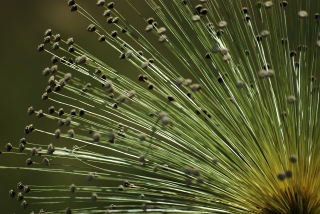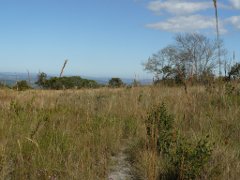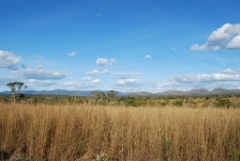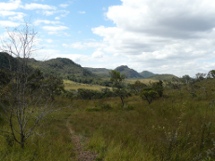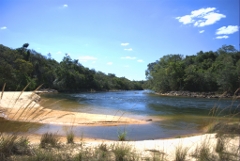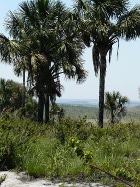
* 11 different types of vegetation compose cerrado biomass
(forest divided into training, savanna and rustic savanna vegetation formation).
(forest divided into training, savanna and rustic savanna vegetation formation).
- The Cerrado -
Savannas training.It has four major subtypes:
- the dense cerrado,
- the tipical cerrado,
- the arid cerrado (not many of species),
- the uneven cerrado (rocky).
In general, the vegetation in the form of low-height shrubs, the tortured form, often inclined twisted e.
Herbaceous plants, grasses and small shrubs, often scattered, are often a refuge for animal fauna consists of beautiful little animals.
The trunks are often covered with a thick bark and the apical ends are also protected in a significant amount of hair.
The leaves are hard, twisted, and often reflect a strong adaptation to climatic conditions.
Although not missing virtually no water (period of substantial rainfall and water table this for much of the coverage of the cerrado), difficult for the cerrado remain in the constitution of the soil.
It contains mainly fine structure of soil, light or dark red color, acids, however this much less than those in the exposed parts.
Very often it is the deficiency in certain micronutrients problematic when its ability to regenerate after the many natural fires or from the hand of man. Here, the tree cover does not exceed 5 to 20% of the whole.
- with a coverage of 5 to 20%, it is called cerrado ralo,
- with a coverage of 20 to 50%, it is called cerrado típico,
- with a coverage of 50 to 70%, it is called cerrado denso ...
- The dirty field -
The concept of savannah (land formations generated) is present here, with the presence of small shrubs éparces amid grasses and herbaceous plants.Some experts differrentiate between two different categories the type of vegetation of the cerrado:
*the strewn terrain as described above may be in a type of soil with a deep ground water, and in this case, vegetation will dry rather dominant hence the name - campo sujo seco (dirty dry field).
*The same ground but here in an environment with a ground water the nearest the surface, and in this case, vegetation will be rather wet dominant hence the name - campo sujo úmido (dirty wet field).
*And a part of this land can consist of mounds hence the name - campo sujo with murundus (mounds of land more or less important).
All these variations, both in the type of soil, moisture, depth and fertility and also according to its relief have important consequences for the organization and the types of plants present.
This type of cerrado is found in rocky places with outcrops or boulders, and are also poor soil nutrients for plants.
There are plants such as the sombrero, the canela-de-ema, or curriola.
- The Clean field -
These are the parts of the cerrado (land formations emerged) occupied mainly by grasses and herbaceous plants.This aspect of low height allows better visibility on wildlife.
The development of a number of species can not be done in good conditions because of the poor soil with organic nutrients and acidity.
We can distinguish three types campo limpo:
- the campo limpo dry,
- the wet campo limpo which includes regularly flooded parts that are called várzeas (banks) or brejos (swamps),
- and from time to time, may be encountered small parts of the higher terrain called campo limpo with murundus (mounds of earth).
Changes in the type of soil, moisture, depth of soil fertility and also the terrain (slopes, hills, mountains) can have serious consequences on the location and type of vegetation.
The latter is subject to frequent fires (natural or manmade unfortunately), and because of the impossibility for the root system to reach ground water, they are a real threat to the renewal of the fauna.
However, species that are implanted them have great potential for germination during the first rains.
This type of cerrado is found very often in chapadas (for example the Chapada dos Veadeiros of Goiás State), either near water sources in the blanks massive.
- The rocky terrain -
This name does not unanimous as it can easily seem similar to the previous two names already submitted.It is characterized by its rugged terrain, its altitude above 900m and its exposure to often frequent winds, as well as high temperatures during the day and cool at night.
We meet a predominance of herbaceous plants and small shrubs little developed and as you climb in altitude, species typical of these rock outcrops, endemic species such as plants of the orchid family (which can grow the rock as some plants from the family Araceae), grasses and carnivorous plants.
These plants (bromeliads, orchids, ...) can be adapted to particular types of soils (rocks, rocky soils, steep, shallow land thickness, ...) are called plants with many soil factors ou edaphics fators.
Carnivorous plants like poor soils, and thus capture insects for removing the constituents of its proteins.
We can easily understand that depending on the situation, the vegetation is much varied, especially in these difficult terrain where erosion, runoff causes sediment accumulations in places, where different plants will emerge from the ones on the slopes thin lands for example.
On the other hand, this type of land is distinguished by the presence of trees, not shrubs.
- The Cerrado 's Park -
This refers to a greater or lesser formation forming a mound or hill on which grow grouped shrubs. Their height can reach 3-6 meters.But a lot remains imperceptible to the eye like formations called murundus or monchões.
The number of small on-high savanna formations can be significant.
When their origin, opinions vary, although many believe that they are the result of insects called cupim which over the time would come to form huge mounds.Flora encountered is identical to the cerrado in general.
- The Dry Forest -
Mata Seca is the training of forest biomass cerrado who do not have link with the river.This type of vegetation occupied mainly reliefs somewhat comb that dominate the richest valleys in nutrients. The development of the flora much depends on the chemical and physical composition of the soil, and their deep (often varying depending on the height of the shoulders). The development of these plants will thus be varied.
Thus appear three subdivisions:
-the mata seca evergreen,
-the semiarid mata seca (or falling leaves varies according to species and climate),
-the arid mata seca (or all of the vegetation loses its leaves at some point).
For each of these divisions, the leaves will fall contributed to an increase of organic matter in the soil.
Soil types are varied, it will land included in the basic rocks of high fertility, average fertility of deep red soils or calcareous soils.
- O Cerradão -
The tree cover is more or less dense, tree height being between 8 and 15 meters away. The brightness ground is low, but sufficient for the growth of other shrubs or herbaceous plants, but much less significant in the rest of the cerrado.The humus formation develops through the decomposition of leaves and organic matter initiate mainly by the action of microorganisms and fungi in large numbers.
This can only improve the cerrado soils whitch are largely deep, well drained, low at medium fertility and sharpness acidity.
- The Mata Ciliar -
It is composed of high vegetation, dense (20 to 25 meters high) that borders rivers and more or less important rivers, which will lose its leaves during drought.It forms relatively narrow bands (100m wide) depending on the bed of the stream.
This close to the rivers that we can find a more dense and high vegetation, with for example the following species:
*peroba with the botanical name Aspidosperma polyneuron and different popular names by region:
amargoso, guatambu-amarelo, ibirá-ró-mí, marela, paroba-amargosa, pau-caboclo, peroba, peroba-açu, peroba-amarela, peroba-amargosa, peroba-branca, peroba-osso, peroba-rosa, peroba-comum, peroba-de-são-paulo, peroba-do-rio, peroba-mirim, peroba-miúda, peroba-paulista, peroba-rajada, peroba-verdadeira, peroba-vermelha, perobeira, perobinha, perova and sobro.
*aroeira with the botanical name Schinus terebinthifolius belonging to the Anacardiaceae family and with different popular names by region:
aroeira-mansa, aroeira-brasileira, aroeira-vermelha, cabuí, cambuí, fruto-de-sabiá, aguaraíba, aroeira-da-praia, aroeira-do-brejo, aroeira-pimenteira, bálsamo, corneíba, aroeira-do-paraná.
*Inga the family Fabaceae, subfamily Mimosoideae with the most known species.
Inga edulis width popular name ingá cipó,
Inga vera,
inga cinnamomea width popular name ingá açú,
nga edulis,
inga quadrangularis width popular name ingá peua,
four of the 300 known species of this genus that are differentiated by wearing leaves or fruit shape.
*ipê of Bignoniaceae family, subfamily Magnoliopsida ...
The various varieties of ipê respectively receive such name, the name attached to the color of its flowers or its timber.
Those that stand out are somewhat generally the Bignoniaceae which are spread across 120 genera and about 800 species.
ipê-amarelo ou ipê comum (genus tecoma longiflora) - up to 25 m high (widespread in the States of Minas Gerais, Rio de Janeiro, São Paulo, Mato Grosso and Goiás,
ipê-branco or ipê-mandioca (genus tecoma Alba) - is found in the states of Minas Gerais, Rio de Janeiro and Paraná,
ipê-tabaco (genus tecoma insignis) – the tree the smallest of all, however, with significant foliage,
ipê-contra-a-sarna (genus tecoma impetiginosa),
ipe-roxo or ipê-rosa (genus tecoma heptaphylla) – occurs from the state of Piauí to that of Minas Gerais, São Paulo and Goiás,
ipê-do-Brejo (genus tecoma umbellata) – this is most common in ponds and swamps of rivers of Minas Gerais and São Paulo.
- The Galeria's Mata -
The other type consists of forest vegetation that accompanies the small flows in rivers and streams plateaux of central Brazil forming closed corridors (galleries) over the river or in the bottoms of small valleys or swamps formed by streams that make their clearly defined path (Ratter and al., 1973; Ribeiro and al., 1983).It consists of trees that have a leaf system that will not fall during the drought period.
These trees can reach a height of 20 to 30 meters, with an overlay treetops under which meets a lot of varieties of epiphytes (orchids mainly).
These places can be separated into subtypes that are the Mata de Galeria &"not flood" and that "flood", wet strong and have accumulated a large amount of organic materials that give the earth the dark black color.
We can meet with among others the following trees:
*the copaíba whose botanical name is Copaifera officialis of Caesalpinaceae family. It occurs in the states of Minas Gerais, Goiás, Mato Grosso do Sul, São Paulo and Parana.
It can ateindre height of 35 meters, but is found more with a height of 10 to 15 meters away.
The common names attributed to this tree are:
pau-de-óleo, pau-d'alho, árvore milagrosa, mari-mari, copaíba roxa, copaíba vermelha, bálsamo.
*the pindaíba whose botanical name duguetia lanceolata St. Hil is the Annonaceae family.This tree can have a height of between 9 and 20 meters and is found in the states of Minas Gerais, Rio de Janeiro, São Paulo, Paraná, Santa Catarina and Rio Grande do Sul.
The vernacular names by which this tree can be called are:
pindaíva, pindavuna, Corticeira, perovana, pinda- ubuna, pindabuna, beribá, pinhão. *the marinheiro whose botanical name is Licania kunthiana of Chrysobalanaceae family.
Its height varies between 7 and 11 meters.
The vernacular names by which it can be called are:
Marinheiro Oiti da mata.
Some species can be found in two subtypes of Mata de Galeria.
- The Vereda -
These spaces are often interspersed with herbaceous plants and grasses which grow amidst the buriti palm trees.The botanical name of this species is Mauritia flexuosa L. f. .
They like moist areas, places where are sources or streams.
In the native language, the word means buriti tree of life because they consider it is able to provide all the elements necessary for life, from raw material to build his house and to be used for food.
It is a tree of the family Palmaceae which one benefits from all parts of the plant.
Common names that may be encountered are:
miriti (Pará), moriti, muriti, boriti, coqueiro-buriti, carandá-guaçu, carandaí-guaçu, palmeira-dos-brejos.
Its general characteristics offer a height of 20 to 30 meters and it is found in the Amazon, in the northern or the Nordeste, in the Central West and central Brazil, reaching its southern boundary on the border with the state of São Paulo.
This tree is widely distributed in the country, forming homogeneous natural groupings as detailed as they are detected by satellite images - the estuary islands of the Lower Tocantins in the State of Pará or wetlands in the state of Bahia (Great Sertão Veredas).
This vegetation is often lined of spaces of type Campo Limpo such areas, and are home to many birds and aquatic fauna.
Needless to say, this space plays an important role in the balance of these ecosystems.
- The Palmeiral -
Bordering the cerrado arises this vegetation consists of four main subtypes determined by a dominant species of palm that are:*the macauba whose botanical name is Mr. Acrocomia sclerocarpa of the family Arecáceas.
He gave his name to the subtype of Palmeiral Macauba.
Common names defining this species are:
macaúva, macaúba, macauveira, coco-de-espinho ou coco-baboso, macaíba.
This palm species is native of Brazil and occurs from the state of Pará to that of São Paulo, Mato Grosso do Sul and Rio de Janeiro.
Its presence indicates fertile soils.
Its height can reach 15 meters and its fruits are edible: we also extracted a fine oil similar to olive oil.
From the middle of the trunk, it makes a nourishing starch and fiber sheets are used to develop hammocks or fishing lines. The wood is used in rural construction.
*the guariroba whose botanical name is Syagrus oleracea (Mart.) Becc. is the Arecaceae family.
This is the second subtype of Palmeiral called Guerobal.
Common names defining this species are:
guariroba, gueiroba, gariroba, palmito-amargoso, catolé, coco-babão, pati-amargoso, coco-amargoso.
Its distribution is at the states Bahia to Paraná, also including the states of Mato Grosso do Sul, of < span class='gdtxtgras'>Goiás, Mato Grosso, Tocantins and Minas Gerais. Its height varies from 5 to 20 meters.
*the babaçu Its botanical name Orrbignya speciosa (Mart.) Barb. Rodr..
This is the third subtype of Palmeiral and is called Babaçual.
Common names are:
baguaçu, coco-de-macaco et dans le dialecte tupi: uauaçu.
It is a tree of the family Arecáceas.
The babaçu is one of the most important representative of Brazilian palm trees.
*the buritti whose botanical name is Mauritia flexuosa L. f., belongs to the family of Arecáceas.
It occurs in poorly drained areas and gave its name to the last Butitizal subtype of Palmeiral.
The common names are:
miriti (Pará), moriti, muriti, boriti, coqueiro-buriti, carandá-guaçu, caranda-guaçu, palmeira-dos-brejos.
It is a tree in which each part is used for special purposes such as wood, palms and fruits.
Documentation source :
− review Darcy (September and October 2009) published by the University of Brasilia UnB,
− publication Cerrado Brasileiro of the collection Biomas do Brasil,
− Vol.1 CERRADO - Ecologia e Flora publicada pela Embrapa e os Editores Ténicos Sueli Matiko Sano, Semíramis Pedrosa de Almeida e José Felipe Ribeiro
− review Darcy (September and October 2009) published by the University of Brasilia UnB,
− publication Cerrado Brasileiro of the collection Biomas do Brasil,
− Vol.1 CERRADO - Ecologia e Flora publicada pela Embrapa e os Editores Ténicos Sueli Matiko Sano, Semíramis Pedrosa de Almeida e José Felipe Ribeiro
